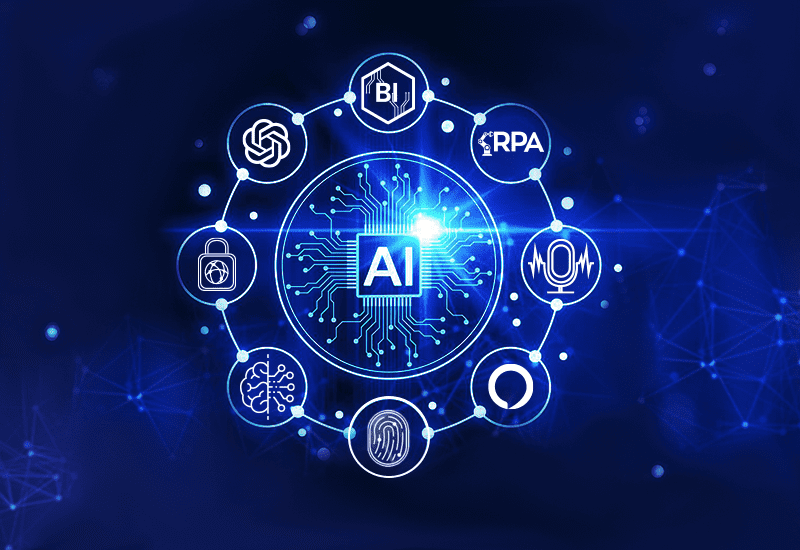Unleashing the Potential: Generative AI and Its Impact on Business
Understanding the practical applications in business, including streamlining workflows, enhancing customer experiences, and driving operational efficiencies.
Kelsey Young, Copywriter and Media Specialist
6 Min Read

When someone talks about Generative AI, they are referring to a type of artificial intelligence that can create new content, data, or solutions that didn’t previously exist. This technology uses algorithms and neural network models to generate outputs such as text, images, audio, and other media.
Generative AI systems learn from large datasets to understand patterns, styles, or structures. Unlike traditional AI that primarily analyzes and processes existing information, generative AI can produce novel and original outputs. This can range from creating new artwork to composing music, writing articles, or developing entirely new product designs.
Generative AI can generate text, speech, images, music, video, and code, offering potential applications in streamlining workflows and processes within businesses. It can automate actions, integrate external and internal data, and eliminate the need for complex software interfaces and menus, thereby simplifying user interactions. Moreover, organizations can leverage generative AI for data integration from different sources and maintaining a standard data schema, contributing to more efficient and effective operations.
Decoding Generative AI
Generative AI, often referred to as generative adversarial networks (GANs), is a subset of AI that has garnered significant attention in recent years. It employs deep learning techniques to create new content that closely mirrors the input data it was trained on. This includes images, videos, and text.
So, how does generative AI function? It comprises two main components: a generator and a discriminator. The generator synthesizes data to create new content based on patterns learned from a training dataset. On the other hand, the discriminator evaluates the authenticity of the generated content. Through an iterative process, the generator and discriminator collaborate to enhance the quality of the generated content.
There are various types of generative AI models, each with its own unique characteristics and applications. Some popular models include:
- Variational Autoencoders (VAEs): VAEs are used for generating new data points by learning the underlying distribution of the training data. They are often used for tasks like image generation and data synthesis.
- Recurrent Neural Networks (RNNs): RNNs are widely used for generating sequences of data, such as text or music. They are capable of capturing temporal dependencies and generating coherent and context-aware output.
- Generative Adversarial Networks (GANs): GANs are a powerful class of generative models that involve a generator and a discriminator competing against each other. They have been successfully applied to various tasks, including image synthesis, style transfer, and data augmentation.
Generative AI has numerous real-life applications in various business sectors. Here are a few examples:
- Content Generation: Generative AI can be used to automatically generate product descriptions, blog posts, or social media content, saving time and effort for businesses.
- Image Synthesis: By training GANs on a large dataset of images, businesses can generate realistic and high-quality images for marketing materials or product prototypes.
- Virtual Try-On: Generative AI can be used in the fashion industry to create virtual try-on experiences, allowing customers to visualize how clothing or accessories would look on them without physically trying them on.
Generative AI represents a significant leap in the ability of machines not just to learn and analyze, but also to create and innovate, opening a wide range of possibilities for future technological developments. By leveraging generative AI, businesses can enhance their creativity, streamline content generation processes, and improve customer experiences.
Advantages of Generative AI for Businesses
Generative AI, also known as generative adversarial networks (GANs), has revolutionized the way businesses operate by providing numerous benefits. Let’s explore some of the key advantages of using generative AI in businesses:
Boosting Productivity and Efficiency: Generative AI can enhance productivity and efficiency in various business processes. By automating repetitive tasks and generating content, GANs enable employees to concentrate on more complex and strategic activities. This reduces manual labor, increases output, and ultimately leads to cost savings.
Enhancing Personalization and Customer Experiences: Generative AI enables businesses to create highly personalized experiences for their customers. By analyzing large amounts of data, GANs can generate personalized recommendations, advertisements, and product suggestions. This level of personalization not only improves customer satisfaction but also increases the likelihood of repeat business and customer loyalty.
Reducing Research and Design Time: Traditional research and design processes can be time-consuming and resource intensive. Generative AI streamlines these processes by automating the generation of designs, prototypes, and simulations. This significantly reduces the time and effort required for research and design, allowing businesses to bring innovative products and solutions to market faster.
Types of Generative Artificial Intelligence to Help Your Business Grow
- Machine Learning Platforms: These are used for predicting and classifying data, essential for data analytics, customer segmentation, fraud detection, and market analysis.
- Chatbots and Virtual Assistants: AI-powered chatbots and virtual assistants can handle customer queries, support tasks, and improve overall customer service efficiency.
- Natural Language Processing (NLP): NLP helps in understanding and interpreting human language, useful in sentiment analysis, customer feedback analysis, and automated content creation.
- Robotic Process Automation (RPA): RPA is used for automating repetitive, rule-based tasks, significantly improving operational efficiency, and reducing human error.
- AI-Optimized Hardware: Hardware designed specifically to run AI-oriented computations, enhancing the speed and efficiency of AI applications.
- Business Intelligence Tools: These tools use AI to analyze complex business data to provide actionable insights, driving strategic business decisions.
- Predictive Analytics: AI in predictive analytics helps businesses anticipate market trends, customer behaviors, and potential risks.
- Speech Recognition: Transforms and transcribes human speech into a useful format for computer applications, beneficial in customer service and voice-controlled systems.
- Biometrics: Involves identification and verification of individuals based on their physical characteristics, useful in security and authentication processes.
- Text Analytics and NLP: Used for unlocking the potential of unstructured text data, including customer feedback, emails, and social media content.
- Cyber Defense: An AI application that can detect and defend against cyber threats by analyzing patterns and anomalies.
- Content Creation AI: AI systems capable of generating content for websites, blogs, advertising copy, and even basic news reports.
Each of these AI technologies can be tailored to fit specific business needs and can significantly enhance operational efficiency, customer experience, and decision-making processes. It’s important for businesses to evaluate their unique requirements and resources before choosing the right AI solutions to implement.
Key Considerations for Implementing Generative AI
When implementing generative AI in businesses, there are several important considerations to keep in mind. These considerations include responsible use of generative AI, ethical and privacy considerations, and building a governance framework.
Responsible use of generative AI is crucial to ensure that the technology is used in a way that benefits both businesses and society. It is important to consider the potential impact of generative AI on various stakeholders, including employees, customers, and the broader community. Transparency and accountability should be emphasized to build trust and mitigate any potential risks associated with the technology.
Ethical and privacy considerations are also paramount when implementing generative AI. Businesses must ensure that their use of generative AI aligns with ethical standards and respects user privacy. This includes obtaining proper consent, safeguarding sensitive data, and implementing measures to prevent bias or discrimination in the generated outputs.
Building a governance framework is essential to effectively manage the use of generative AI within an organization. This framework should outline clear policies, guidelines, and procedures for the responsible and ethical use of the technology. It should also establish roles and responsibilities, define decision-making processes, and provide mechanisms for ongoing monitoring and evaluation.




